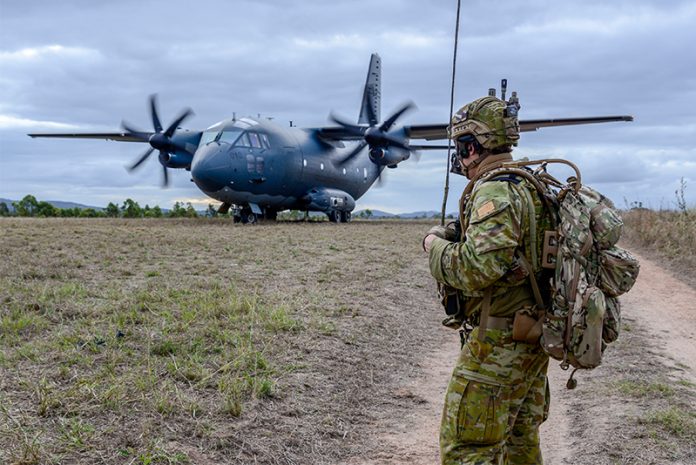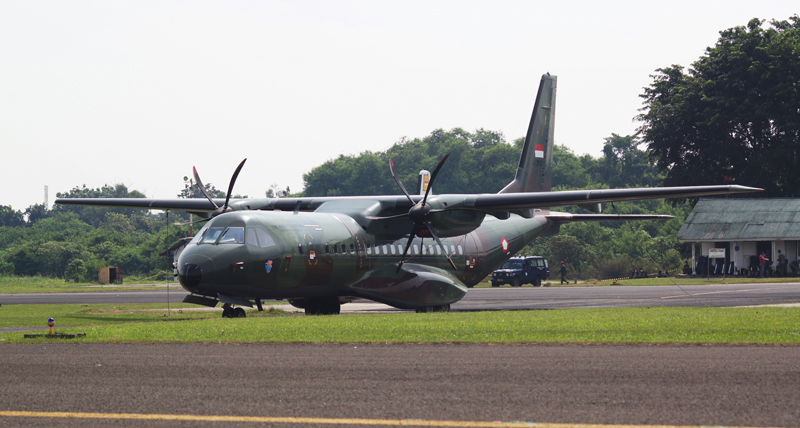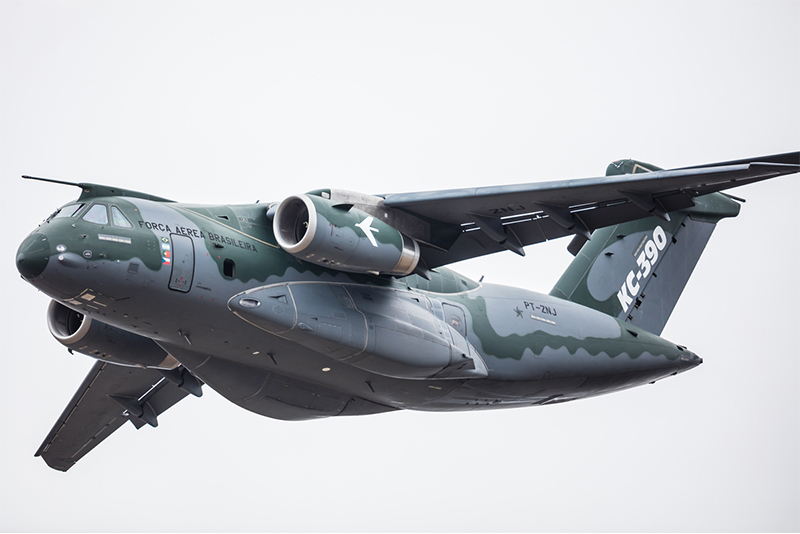
There is an impressive range of dedicated transport aircraft now carrying military air cargo around the region.
In the list of air forces’ priorities, transport/cargo aircraft tend to come low after combat and training aircraft requirements. One of the reasons for this is that transport/cargo aircraft have a longer service life than other types in air force inventories, and that they can be upgraded relatively easily and cheaply.
Twin turboprop tactical transport aircraft have proved popular around the world and in Europe in particular where the market has been dominated by the Airbus C-295M and the Leonardo C-27J Spartan.
Developed from the CASA CN-235 which is in service with the French Air Force, the high wing C-295M is powered by two 2,645shp (1.972kW) Pratt & Whitney Canada PW127G turboprop engines driving six-bladed composite propellers. It can carry 71 troops or a maximum payload of 20,392 lb (9.250 kg) of cargo loaded via the rear ramp/door. Sold to 31 countries, small numbers of the C-295M are in service with the air forces of the Philippines, Thailand and Vietnam. Although the type has been selected by the Indian Air Force to replace its fleet of ageing An-32 and HS748 transports, the contract has yet to be signed.

The Leonardo C-27J Spartan was a development of the FIAT G222 that first flew in July 1970. The redesigned C-27 flew twenty-nine years later powered by two 4,367shp (3,458kW) Rolls-Royce AE 2100D2 turboprops also driving six-blade composite propellers. Equipped with a hydraulically operated rear-loading ramp and upward opening door, the C-27J can accommodate up to 68 fully equipped troops or carry a maximum of 25,353lb (11,500kg) of cargo.
The only C-27J customer in the Asia Pacific region is Australia. The RAAF, ordered ten Spartans with deliveries beginning in late 2014. Operated by No 35 Squadron, the first aircraft reached initial operating capability (IOC) in December 2016. The final aircraft was received by the RAAF on 18 April 2018.
The world’s most popular tactical military transport aircraft is the four turboprop Lockheed C-130 Hercules that first flew in August 1954 with more than 2,000 delivered by 1998. Development of a new generation version, the C-130J began in 1991 powered by four 4,590shp (3,424kW) Rolls-Royce AE 2100D3 turboprop engines driving six-blade composite propellers. Standard complement for the C-130J is 92 fully equipped troops although the stretched C-130J-30 variant can carry up to 128 troops. The maximum payload of the C-130J and C-130J-30 is 41,800lb (18,965kg) and 48,00 lb (21,772kg) respectively. The hydraulic operated rear loading door and ramp can be opened in flight for airdrop operations of paratroops or cargo at up to 250kts.
In March 1995 Lockheed Corporation merged with Martin Marietta to become Lockheed Martin and the UK Royal Air Force (RAF) was the first export customer for the C-130J with the first delivery taking place in November 1999. Australia was another early customer ordering 12 C-130J-30s followed by South Korea and India. Recently, the Bangladesh Air Force received one aircraft in August 2019 and New Zealand has selected the aircraft to replace its fleet of five C-130Hs.

The Lockheed Martin C-130J has a rival STOL tactical military transport in the recently designated Embraer C-390 Millennium. In 2009, the Brazilian Air Force (FAB) contracted Embraer to design, develop and manufacture the aircraft as a replacement for its ageing C-130 fleet. The C-390 Millennium received its Civil Certification from the Brazilian National Aviation Agency (ANAC) in 2018 and is now in full production.
Powered by two 31,330lb (139.4kN) thrust IAE V2500-E5 turbofan engines, the C-390 has a fly-by-wire control system, and its NVG-compatible cockpit is equipped with fully interactive and CNS/ATM compliant Rockwell Collins Pro Line Fusion Suite. It is equipped with an advanced tactical radar, featuring Spotlight Synthetic Aperture Radar (SAR), with weather, air-to-air, navigation, air-to-ground and high resolution modes. The C-390’s self-protection system combines a broad range of radar warning, laser warning and missile approach warning, chaff and flare and Directional Infrared Counter Measures (DIRCM) to enhance the aircraft’s security in hostile scenarios. Up to 80 troops or 66 fully equipped paratroopers, or loads of up to 42,000lb (19,000kg) can be air dropped via the rear loading ramp. The designation KC-390 will be maintained for the customers that have opted for the aerial refuelling capability.
The Brazilian Air Force (FAB) received its first aircraft on 4 September 2019. Portugal has signed a contract to acquire five aircraft with deliveries scheduled for 2023 and the Czech Republic has an option for two C-390s. International marketing of the Millennium is being handled by a joint venture company between Embraer and Boeing. To date no Asian customers have been identified.

Moving up the scale of airlifters is the Airbus A400M which has had a protracted development since its first flight in December 2011. Powered by four 11,000shp (8,200kW) Europrop International TP400-D6 turboprop engines driving eight-blade propellers, the A400M has a fly-by-wire control system and has a NVG-compatible glass cockpit designed by Thales and is fitted with an Integrated Modular Avionics (IMA) suite. The cockpit high-definition imagery of the outside environment is via an Enhanced Vision System (EVS) pre-fitted with a dual Head-Up Display (HUD), giving pilots additional efficiency during high workload procedures and low visibility conditions.
The A400M can accommodate up to 116 fully equipped paratroopers and airdrop up to 55,100lb (25,000kg) of containers or pallets through gravity and parachute extraction. The computed air release point (CARP) linked to the automated release system, automatically computes the release point for optimum delivery accuracy, including corrections for wind effects.
The main reason for the delays in the development programme have been due to engine and gearbox problems with the largest turboprop powerplant ever produced in the West. As recently as November 2019 the German armed forces have decided not to accept two Airbus A400Ms for delivery due to recurrent technical problems that routine inspections of the propeller assembly of Luftwaffe’s 31 A400Ms already flying discovered that not all the 24 nuts per propeller had the intended torque load. The Luftwaffe added that inspections were also required of the engine mounts, combustion chambers, and engine flaps, as well as to check for cracks.
A total of 100 A400Ms had been delivered by the end of 2019 out of 174 ordered by Belgium, France, Germany, Luxembourg, Spain and Turkey with Malaysia the only non-European customer to date taking four aircraft.
The A400M was seen as a competitor to the four jet Boeing C-17A Globemaster III which is now out of production. Flown for the first time in September 1991, powered by four 40.400lb (179.9kN) thrust Pratt & Whitney F117-PW-100 turbofans, the C-17A was the first military transport with all-digital FBW control system. The glass cockpit has full-time all-function head-up displays (HUD), four multi-function active matrix liquid crystal displays and integrated radio management system with communications system open architecture (COSA). For self protection it is equipped with the Northrop Grumman laser-based large aircraft infrared countermeasures (LAIRCM) system.

With accommodation for up to 200 fully armed troops, the C-17A can transport 100,000lb (45,360kg) of freight more than 4,500nm (8,334km) while flying at altitudes above 35,000ft. The aircraft’s design enables high-angle, steep approaches at relatively slow speeds, allowing it to operate into small, austere airfields and onto runways as short as 3,500ft (1,066m) long.
While the bulk of the 275 production aircraft were delivered to USAF, the UK was the first and only European export customer for the C-17A with the first of seven delivered in May 2001.
Australia was the third customer for the C-17A that acquired eight aircraft operated by No.36 Squadron at RAAF Amberley, the first of which was delivered in November 2006.
In June 2009, the Indian Air Force (IAF) selected the C-17A for its Very Heavy Lift Transport Aircraft requirement. and In January 2010, requested 10 C-17As through the United State’s Foreign Military Sales (FMS) programme. Following the completion of trials with a USAF C-17A, the IAF and Boeing agreed terms for $4.1 billion order of 10 aircraft in February 2011with an option for six more with deliveries beginning in June 2013. However, when India exercised its option for six additional aircraft, the C-17A was no longer in production.
In 2015 the New Zealand Defence Force had considered the purchase of two C-17As for the Royal New Zealand Air Force at an estimated cost of $600 million to replace its ageing C-130s, but eventually decided to buy five C-130Js.
There is no new tactical or heavy airlifter design on the horizon in the West and existing fleets are liable to be upgraded rather than replaced in the forseeable future.
by David Oliver












